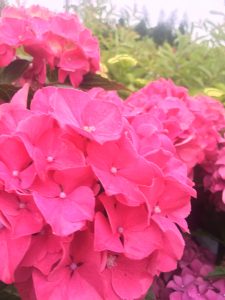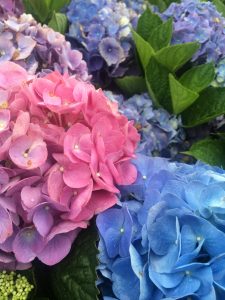 Hydrangeas are funny ducks. Sometimes their flowers are blue. Sometimes they are pink. Sometimes they are purple. Sometimes they are red, sometimes they are fuchsia. Sometimes they are white. Sometimes they are a combination of all these colors. We love the great variety of colors that these quintessentially Nantucket plants can bring to the garden, but many gardeners prefer one over another. Traditionally, pastel blue has been the most sought after. It seems simple enough. Buy a blue hydrangea, plant it – done! But with Hydrangeas it’s just not that simple. So often, a gardener will buy a blue-flowered Hydrangea, plant it and find it bloom some other color the following year. They puzzle over it. They come in to the nursery saying, “I’m sure I planted ‘Nikko Blue’ it was perfect last year, now it’s pink!” So what’s going on?
Hydrangeas are funny ducks. Sometimes their flowers are blue. Sometimes they are pink. Sometimes they are purple. Sometimes they are red, sometimes they are fuchsia. Sometimes they are white. Sometimes they are a combination of all these colors. We love the great variety of colors that these quintessentially Nantucket plants can bring to the garden, but many gardeners prefer one over another. Traditionally, pastel blue has been the most sought after. It seems simple enough. Buy a blue hydrangea, plant it – done! But with Hydrangeas it’s just not that simple. So often, a gardener will buy a blue-flowered Hydrangea, plant it and find it bloom some other color the following year. They puzzle over it. They come in to the nursery saying, “I’m sure I planted ‘Nikko Blue’ it was perfect last year, now it’s pink!” So what’s going on?
There are several factors that affect Hydrangea flower color. The species of Hydrangea, the availability of aluminum in the soil, the time of year, and the amount of pigment in the flowers.
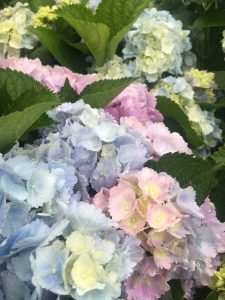 Not all Hydrangeas are able to change their flower color in the same way. Mop head Hydrangeas, Hydrangea macrophylla (the ones with big, round, squishy flower heads), are very susceptible to aluminum. If mop head Hydrangeas absorb aluminum from the soil, the flowers will be blue or purple. If there is no aluminum in the soil, or it is chemically unavailable to the plant, the flowers will be pink. In addition, the soil must be acidic or the plant cannot absorb aluminum. In soils 5.5 and higher on the ph scale the aluminum is “locked up” and cannot be absorbed. Planted in soil that has a ph lower than 5.5, the aluminum is easily taken up by the plants causing blue flowers, even in plants that are meant to be pink. So, you can easily have a blue ‘Forever Pink’ Hydrangea. The reverse is also true. A ‘Nikko Blue’ Hydrangea will be pink in alkaline soils.
Not all Hydrangeas are able to change their flower color in the same way. Mop head Hydrangeas, Hydrangea macrophylla (the ones with big, round, squishy flower heads), are very susceptible to aluminum. If mop head Hydrangeas absorb aluminum from the soil, the flowers will be blue or purple. If there is no aluminum in the soil, or it is chemically unavailable to the plant, the flowers will be pink. In addition, the soil must be acidic or the plant cannot absorb aluminum. In soils 5.5 and higher on the ph scale the aluminum is “locked up” and cannot be absorbed. Planted in soil that has a ph lower than 5.5, the aluminum is easily taken up by the plants causing blue flowers, even in plants that are meant to be pink. So, you can easily have a blue ‘Forever Pink’ Hydrangea. The reverse is also true. A ‘Nikko Blue’ Hydrangea will be pink in alkaline soils.
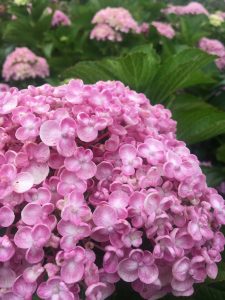
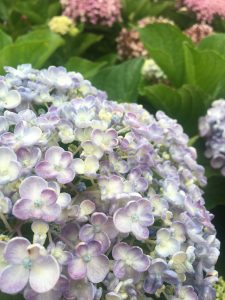
Generally, Nantucket’s soils are lean and acidic, but not always! If your blue Hydrangeas come out pink, aluminum sulfate can be added to the soil, changing them to blue. It may take several applications, a few weeks apart, or even a whole growing season to get the color you are looking for. Simply dilute the product in water and drench the soil around each plant, making sure to avoid the leaves. Take care to follow the application rate on the package, as too much can burn the roots. If your pink Hydrangea blooms blue, add lime to bring the ph closer to neutral. Phosphorous also affects the availability of aluminum. In order to keep the aluminum available, (and flowers blue) make sure to use a low-phosphorous fertilizer. Choose a fertilizer with higher phosphorous to inhibit the aluminum, if you prefer pink.
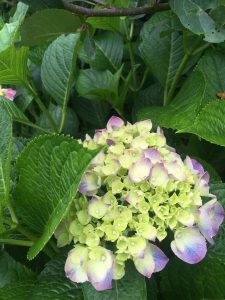 The age of the flower and the time of year will also affect color. Early in summer, most varieties will appear paler, almost bi-color, with most of the color showing at the edges of each floret. As the flowers mature, the color generally becomes more even. Later, as cooler nights arrive, the flowers enter their antique phase, and often appear reddish or deep purple.
The age of the flower and the time of year will also affect color. Early in summer, most varieties will appear paler, almost bi-color, with most of the color showing at the edges of each floret. As the flowers mature, the color generally becomes more even. Later, as cooler nights arrive, the flowers enter their antique phase, and often appear reddish or deep purple.
The quality of the color is affected by the amount of pigment in the flower. Each cultivar is different, but there are basically two groups as far as color saturation is concerned; Pastel and deeply saturated. In cultivars like ‘Glowing Embers’ there is a lot of pigment present in the flowers, allowing for very intense purples and/or pinky-reds. These plants will never be baby blue like ‘Endless Summer’. No matter how much the soil chemistry is changed, there will always be a lot of pigment in these flowers, so they will always have deeply saturated color. Conversely, cultivars similar to Endless Summer® can only produce pastel hues of blue, lilac and soft pink, there just isn’t enough pigment present in the flowers to allow for intense shades.
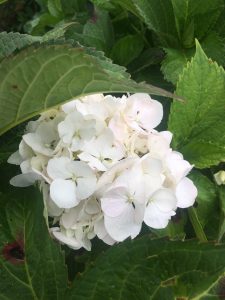 And then there is the whole question of white. ‘Madame Emile Mouliere’, ‘Sister Theresa’ and Endless Summer® Blushing Bride, all purport to have white flowers. Unfortunately, none of these stay clear white all season. With afternoon shade, ‘Madame Emile Mouliere’ and ‘Sister Theresa’ will remain white for several weeks, but eventually take on a tinge of pink, or less often, blue. ‘Blushing Bride’ usually takes on a pale pink hue, as well. We are not aware of any way to keep the flowers white on these plants all season.
And then there is the whole question of white. ‘Madame Emile Mouliere’, ‘Sister Theresa’ and Endless Summer® Blushing Bride, all purport to have white flowers. Unfortunately, none of these stay clear white all season. With afternoon shade, ‘Madame Emile Mouliere’ and ‘Sister Theresa’ will remain white for several weeks, but eventually take on a tinge of pink, or less often, blue. ‘Blushing Bride’ usually takes on a pale pink hue, as well. We are not aware of any way to keep the flowers white on these plants all season.
The take away: If you want a blue Hydrangea, choose one that is bred to be blue, and plant it in acidic soil, using an acidifying fertilizer low in phosphorous. If you’re shooting for pink, choose a variety bred to be pink, plant it in soil closer to neutral and use a balanced fertilizer, with higher amounts of phosphorous. For white blooms, choose ‘Madame Emile Mouliere’, ‘Sister Theresa’ or ‘Blushing Bride’ be sure to give them afternoon shade.

